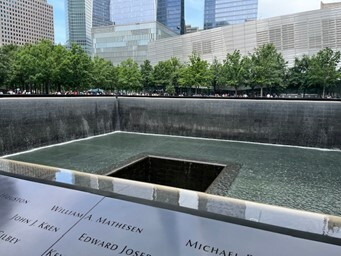Grief and Hope

I wasn’t expecting to be moved like I was when I visited the memorial to 9/11 in lower Manhattan last month. The memorial wasn’t even the focal feature of our trip, and we only viewed the outside portion of the memorial complex without visiting the museum adjacent to it. But after walking the Brooklyn Bridge and continuing on past Wall Street to Battery Park, walking northward to the 9/11 memorial on the way back to our hotel near Times Square seemed like a logical “next step.”
If you have not visited the memorial (and as you can see from the picture), it consists of a rectangular hole in the ground spanning the exact footprint of the original building (there are actually two identical memorials – one for each building – but as one of them was being repaired, we were only able to stand before one). At the center of that hole in the ground is another hole – the bottom of which is not visible from any vantage point around the perimeter. It is an abyss – dark, stark and hollow. Water then runs down the walls of the larger hole, across its floor and then again down into the abyss, as if pulled relentlessly and inevitably into darkness. Regularly and rhythmically the water flows from light into darkness – over and over again, without pause or hesitation, while we – the onlookers – watch; intimately close and yet at the same time impossibly and helplessly far away. The way the water falls, passing over the descending walls and reflected by the sunlight, creates a lattice effect, reminiscent of the twin towers’ original construction. And all along the outside of that massive hole in the ground are etched the names of all who lost their lives because of what happened there that day.
What struck me most was how this was exactly the kind of memorial that symbolizes grief – whether the grief associated with that day or the grief any one of us experiences when the equivalent of the twin towers in our own lives have come crashing down. Grief feels like an abyss; a chasm – an empty void of nothingness. Like a a giant hole has been ripped into your life because something or someone you love very greatly has been ripped out of it. And all you can do is watch – seemingly helpless – as though you were an onlooker standing far off, outside yourself, as tears – the waters of the heart - fall relentlessly into a nothingness the bottom of which you will never reach. Maybe the hardest thing about grief – and what, in fact, makes grief what it is – is the out-of-control-ness of it all. Sometimes you can’t stop the tears from flowing, because you can’t stop the hole in your heart and your life from being there. Nothing you could have done changes the fact that the hole is there – and nothing you can do now is going to make it go away. And its size will always be in direct proportion to the size of the thing you lost that isn’t coming back.
And yet we are never helpless. We may not be in control of the flow of tears nor the place that hole in the world now occupies and all that it represents. But we are in control of something. We are not helpless onlookers and too-distant passersby. We can do something. We can remember what was lost. We can recall their names; the names of those things and those ones swallowed by that hole. Hannah Arendt said that what makes us who we are are two things – the fact that we have a body and the fact that we have a name. The body represents our physicality. The name signifies our soul. When the body is no longer with us, we can remember the name – the soul that never dies nor swallowed by an abyss or chasm no matter how strong the pull toward it may be.
And perhaps this helps us move forward. Because that is also something we can do. We can build a new life – around and alongside the void grief causes – a life that acknowledges the pain of what has happened without being held captive by it. You see right next to the 9/11 memorial is a new tower; One World Trade Center. It doesn’t take the place of the two that came down 23 years ago. Nor does it look exactly like them. But it is tall. It is majestic. And it is a reminder that not even the worst of our losses need prevent us experiencing a future in front of us.
Grief and hope. They forever exist side by side. Maybe they are forever meant to. Which is what I love best about the 9/11 memorial. It depicts this side-by-side nature of grief and hope. All around the memorial are signs of progress and productivity; future possibility and hope. But here, in this garden concrete, steel and water, we allow ourselves to grieve. We acknowledge – and do not run from – the reality of grief in our lives so that we don’t one day get swallowed up by it.
As I stood there, mesmerized by the water running into that abyss, I didn’t grieve for the names etched in metal before me. Nor did I simply grieve for all that happened on 9/11; all that led up to it and all that has resulted from it. But I grieved. And the memorial allowed that grief to find its rightful voice and expression – even for just as few moments.
Blessings – Michael
